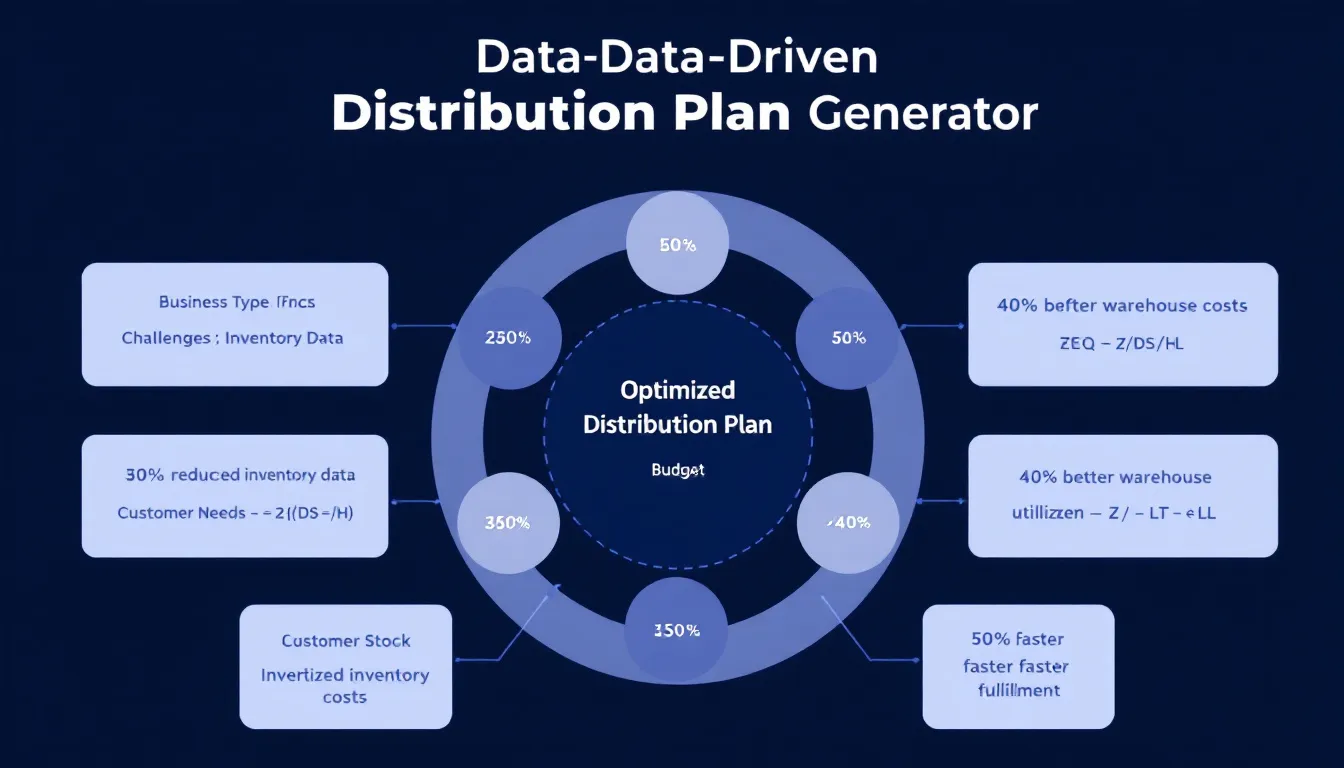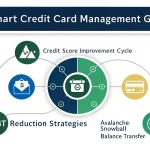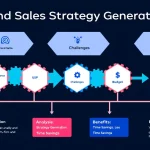Is this tool helpful?
How to Use the Tool Effectively
This data-driven Distribution Plan Generator helps you create a tailored inventory management strategy based on your business needs. Here’s how to fill in each field for the most accurate results:
Input Fields Guide
- Type of business or industry: Specify your business sector. For example, you could enter “Pharmaceutical wholesale” or “Furniture retail.”
- Current distribution challenges: Describe your main distribution issues. Example inputs include “Frequent stockouts during holiday seasons, inconsistent delivery times” or “Rising freight charges affecting profit margins.”
- Inventory management data: Provide key inventory metrics. For instance, “Inventory turnover ratio: 10/year, average lead time: 7 days, warehouse capacity: 20,000 sq ft” or “Monthly carrying cost: $30,000, order accuracy rate: 95%.”
- Customer requirements and preferences (Optional): Detail any special customer needs. Examples: “Fragile item handling, preferred delivery slots between 9 am and 12 pm” or “Subscription customers needing automatic restocking every month.”
- Geographic distribution locations (Optional): List your distribution areas. For example, “Two central hubs serving Southeast Asia, with regional last-mile delivery partners” or “Single warehouse with nationwide coverage including urban and rural zones.”
- Implementation budget (USD) (Optional): Enter the budget you’ve allocated for carrying out the distribution plan, like “75000” or “120000.”
What the Distribution Plan Generator Does
This tool integrates your business data with advanced logistics principles to design an effective distribution strategy. It analyzes inventory metrics, distribution challenges, geographic considerations, and customer demands to deliver a customized plan that optimizes stock levels and delivery efficiency.
Purpose and Key Benefits
- Optimize inventory costs: Reduce excess stock and minimize holding expenses.
- Improve delivery reliability: Address late shipments and meet customer expectations consistently.
- Enhance warehouse utilization: Maximize storage space to support higher throughput.
- Streamline supply chain: Align inventory flow with demand patterns and geographic factors.
Practical Use of the Distribution Plan Generator
This tool works through an easy-to-use form interface that collects detailed inputs related to your distribution system. It then processes this information using sophisticated algorithms to generate actionable insights and recommendations.
Since this operates as a form-based API integration powered by advanced processing (via process_llm_form), it provides real-world application value by:
- Identifying inventory reorder points and optimal stock quantities to prevent overstocking or stockouts.
- Suggesting warehouse consolidation or expansion strategies based on location data.
- Highlighting cost-saving opportunities through route optimization for last-mile delivery.
- Customizing the distribution plan based on customer service levels and preferences.
Core Mathematical Models Behind the Tool
The tool applies fundamental supply chain formulas to optimize inventory and distribution:
Economic Order Quantity (EOQ)
EOQ calculates the ideal order size to minimize total inventory costs.
$$ EOQ = \sqrt{\frac{2DS}{H}} $$- D = Annual demand for the product
- S = Cost per order (fixed ordering cost)
- H = Holding cost per unit per year
Safety Stock Calculation
Safety stock protects against variability in demand and lead time.
$$ Safety\ Stock = Z \times \sigma_{LT} \times \sqrt{L} $$- Z = Service level factor (reflects desired service level)
- sigma_{LT} = Standard deviation of demand during lead time
- L = Lead time in days or weeks
Benefits of Using a Data-Driven Distribution Strategy
Improve Operational Efficiency
- Lower inventory carrying costs by maintaining optimal stock levels.
- Reduce transportation expenses through better route planning and load optimization.
- Increase warehouse throughput and space utilization.
- Shorten order fulfillment times to meet demand faster.
Gain Strategic Advantages
- Make informed decisions based on data-driven insights.
- Enhance customer satisfaction with on-time, reliable deliveries.
- Improve cash flow by aligning inventory investments with demand cycles.
- Allocate resources effectively across your distribution network.
How the Tool Solves Common Distribution Problems
Optimizing Inventory for Variable Demand
For example, a food distributor experiencing fluctuating demand can use the tool to:
- Set monthly adjusted safety stock to buffer against unpredictable order volumes.
- Implement multi-level inventory management across regional centers.
- Automatically calculate reorder points based on demand trends.
Designing Efficient Distribution Networks
For companies with complex geography, the tool helps by:
- Identifying high-demand zones for strategic warehouse placement.
- Finding opportunities for cross-docking to speed up delivery.
- Optimizing routes for last-mile delivery to reduce costs and delays.
Real-World Examples of the Distribution Plan Generator
Case Study 1: Specialty Retail Optimization
A specialty electronics retailer used the tool’s insights to:
- Decrease inventory holding costs by $1.8 million annually.
- Boost product availability from 90% to 97% across outlets.
- Cut transportation expenses by 22% through route redesign.
Case Study 2: Automotive Parts Distribution
An automotive parts supplier achieved significant gains by:
- Reducing warehouses from 10 to 6 with strategic relocation.
- Improving order accuracy to 99%.
- Lowering order fulfillment time by 45%.
Frequently Asked Questions About the Distribution Plan Generator
General Questions
Q: How often should I revisit my distribution plan?
You should review it at least quarterly or whenever your market conditions, customer demand, or supply chain dynamics change significantly.
Q: Does the tool support multiple product lines?
Yes, it handles diverse product categories and can customize strategies based on differing storage and delivery needs.
Q: Who benefits most from this tool?
Companies with multifaceted supply chains, multiple warehouses, or complex customer requirements gain the greatest improvements.
Implementation Questions
Q: What is the typical implementation timeframe for recommended changes?
Depending on the complexity, implementation usually takes between 3 and 6 months to realize full benefits.
Q: Can this tool integrate with current ERP or warehouse management systems?
Yes, it supports integration alongside most major ERP and WMS platforms to enhance your existing workflows.
Q: What kind of return on investment (ROI) can I expect?
Companies typically experience ROI within 6 to 12 months through cost savings and improved service levels.
Technical Considerations
Q: What key performance metrics should I track after using the tool?
Track inventory turnover, order fulfillment rates, transportation and warehousing costs, along with customer satisfaction scores.
Q: How does the tool handle seasonal demand?
The tool factors seasonal fluctuations into inventory and distribution recommendations to maintain optimal stock levels year-round.
Q: Can the tool optimize international distribution?
Yes, it considers international shipping constraints such as customs, transit times, and local regulations to optimize global supply chains.
Important Disclaimer
The calculations, results, and content provided by our tools are not guaranteed to be accurate, complete, or reliable. Users are responsible for verifying and interpreting the results. Our content and tools may contain errors, biases, or inconsistencies. Do not enter personal data, sensitive information, or personally identifiable information in our web forms or tools. Such data entry violates our terms of service and may result in unauthorized disclosure to third parties. We reserve the right to save inputs and outputs from our tools for the purposes of error debugging, bias identification, and performance improvement. External companies providing AI models used in our tools may also save and process data in accordance with their own policies. By using our tools, you consent to this data collection and processing. We reserve the right to limit the usage of our tools based on current usability factors.







